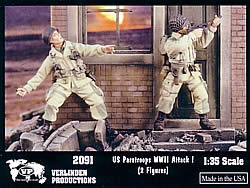| U.S.
Paratroops WWII Attack! |
 |
|
This pair of action figures does a very good job conveying a combat engagement, with one trooper giving cover fire with his Thompson while his cohort prepares to lob a grenade. Both figures are well-sculpted, though the grenade thrower is pretty large-framed (perhaps he's "Bull" Randleman from "Band of Brothers"). He has the typical ammo pouches for carrying Garand ammo, but the set includes no weapon for him. I wish VP, which has been doing a lot of U.S. paratroopers for the past few years, would remember that many of these soldiers carried and used the M1A1 carbine (with the folding metal frame stock). It would not be out of the ordinary for a soldier equipped with such a weapon to use the M1923 cartridge belt, particularly a paratrooper in June, 1944, who would load up on a lot of ammo. But it's easy to tend toward being "safe" in our modeling, especially in competitive situations where some know-it-all will loudly opine "That's wrong!" But it would be nice if the figure manufacturers would realize not all infantry men toted Garands. The partner's Tommy gun comes in two pieces: the stock is molded to the right arm, and the rest of the gun is separate, held by the right arm and hand piece. You need to carefully position the three parts to get the right fit. I suggest gluing the chamber and barrel piece to the stock, and then fixing the right arm to the figure first. That allows you to maneuver the left arm to the proper point. When fixing the torso pieces to the lower body halves (the parts meet at the bottom of the cartridge belts), I gave them a little more twist, while still being true to the alignment of the jacket opening. This gives them just a little more sense of action. I also set the arms on the grenade pitcher a little more extreme than seen in the box photo. It's more dramatic when you can actually sense the muscles straining, the balance being tested. Most figures in action poses do not capture that. These come close. Unfortunately, these figures do not wear the M1942 jump jackets, as the box art implies by the tan color of the jackets and trousers. Actually, the unidentified sculptor has fashioned M1943 OD jackets. I was fooled by the box art at first, but further examination shows the one-button arrow tab on sleeve cuffs, no pleated front hip pockets, and a larger cut lapel—all hallmarks of the M1943 jacket that was introduced to airborne soldiers for Operation Market Garden in September, 1944. So, if you want to use these figures in Normandy, as the box art suggests, you need to make some alterations to the jackets, the most difficult of which will be fixing the lapels. Verlinden has often had problems with accuracy throughout his product line, but this seems to reach a new low. If he and his team can't get a simple uniform correct, what does that suggest for other VP products? What is worse—ineptitude, or a con job? The faces have rather laconic expressions for being in the heat of battle. It would be nice to see more determination, even fear, particularly in the thrower. Curiously, the more expressive of the two heads belongs to the Tommy gunner, with the mesh helmet. Neither head has any paratrooper chin strap as used with the M1C helmet. Again, one gets the standard issue gear from Verlinden. I'm sure that many diorama builders who want to do a Carentan project will enjoy having these figures available, if you don't mind making up for the botched uniform. It would also be possible to do a little mixing and matching with other Verlinden paratroopers, swapping parts with the kneeling figure in the "Para Down!" set to create a kneeling Tommy gunner. Have fun! -tss- |
 |
 |
 |
 |
 |
 |
 |
 |
 |
 |
 |
 |
|
 Verlinden
Productions
Verlinden
Productions